文章信息
- 唐甜, 张丁非, 孙静, 胡光山, 胥钧耀, 潘复生
- TANG Tian, ZHANG Ding-fei, SUN Jing, HU Guang-shan, XU Jun-yao, PAN Fu-sheng
- Sn对时效态ZM61镁合金高温力学性能的影响
- Effects of Sn on Elevated-temperature Mechanical Properties of As-aged ZM61 Alloy
- 材料工程, 2016, 44(11): 9-15
- Journal of Materials Engineering, 2016, 44(11): 9-15.
- http://dx.doi.org/10.11868/j.issn.1001-4381.2016.11.002
-
文章历史
- 收稿日期: 2015-02-03
- 修订日期: 2016-08-02
2. 国家镁合金材料工程技术研究中心, 重庆 400044
2. National Engineering Research Center for Magnesium Alloys, Chongqing University, Chongqing 400044, China
镁合金作为最轻的金属结构材料,具有比强度高,导热减震性好、电磁屏蔽性能优良等特点,在航空航天,电子电工及汽车工程等领域得到广泛的应用[1-4]。然而镁合金的高温强度较低、抗蠕变性能差,高温环境(如汽车发动机零部件)下的应用受阻[5-7]。因此,开发高温性能优良的变形镁合金成为当前研究热点[8, 9]。
Mg-Sn合金为典型的可时效强化合金[10, 11]。由Mg-Sn相图可知,Sn的固溶度随温度降低急剧减小,共晶温度561.2℃下,固溶度为14.48%,温度下降到200℃,固溶度仅仅只有0.45 %[12, 13]。Sn与Mg形成高熔点(熔点为770℃)、热稳定性好的Mg2Sn相[14],为提高镁合金的高温性能提供了可能。
本课题组新开发的Mg-Zn-Mn-Sn系变形镁合金具有优良的室温力学性能[15],但是对其高温力学性能以及断裂机制缺乏相关研究。因此,本工作采用高温拉伸实验来研究ZM61-xSn (x=0,6,8,10,质量分数%,下同)合金在不同温度下的力学行为和断裂机制。
1 实验材料与方法实验合金以纯Mg、纯Zn、纯Sn和Mg-4.1%Mn中间合金为原材料,采用国产ZG-001型10kg真空感应炉进行熔炼,金属模具浇注,通入氩气作为保护气体。熔炼得到4种不同Sn含量的ZM61-xSn (x=0,6,8,10)合金,在XRF-1800CCDEX射线荧光光谱仪(XRF)上对合金的化学成分进行分析,得到结果如表 1所示,基本达到合金设计的要求。
| Alloy | Mg | Zn | Mn | Sn |
| ZM61 | 93.09 | 5.96 | 0.95 | |
| ZM61-6Sn | 87.19 | 6.05 | 0.92 | 5.84 |
| ZM61-8Sn | 84.85 | 6.24 | 0.85 | 8.06 |
| ZM61-10Sn | 83.55 | 5.94 | 0.95 | 9.56 |
将铸锭在SXL-1200高温箱式炉中进行330℃, 15h+420℃, 2h均匀化处理。然后在500t卧式挤压机上正挤压,挤压温度350℃,挤压比25,挤压速率1.5~3m/min。将挤压棒材切割成70mm长的试样,进行440℃, 2h固溶处理和90℃, 24h+180℃, 8h双级时效处理。
对4种时效态合金采用D/MAX-2500PC型X射线衍射仪进行物相分析(XRD),用Olympus光学显微镜进行金相组织观察。按国标GB 228-2002,设计出标距为25mm,标距内试棒直径为5mm的拉伸试样。将拉伸样在CMT-5105微机控制电子万能试验机上进行高温拉伸实验,拉伸温度分别为180,220,260, 300℃,拉伸速率为3mm/min,在每个拉伸温度下保温8min。用TESCAN VEGA IILMU扫描电子显微镜(SEM)和OXFORD INCA能谱分析仪(EDS)对断口形貌和表面微区成分进行观察、分析。
2 结果与分析 2.1 Sn对合金显微组织的影响图 1为时效态ZM61-xSn (x=0,6,8,10)合金的XRD图谱。由图 1可知,ZM61合金的相组成为α-Mg,α-Mn及MgZn2相。添加Sn元素后合金中形成了新的Mg2Sn相,含Sn合金的相组成为α-Mg,α-Mn,MgZn2,Mg2Sn相。
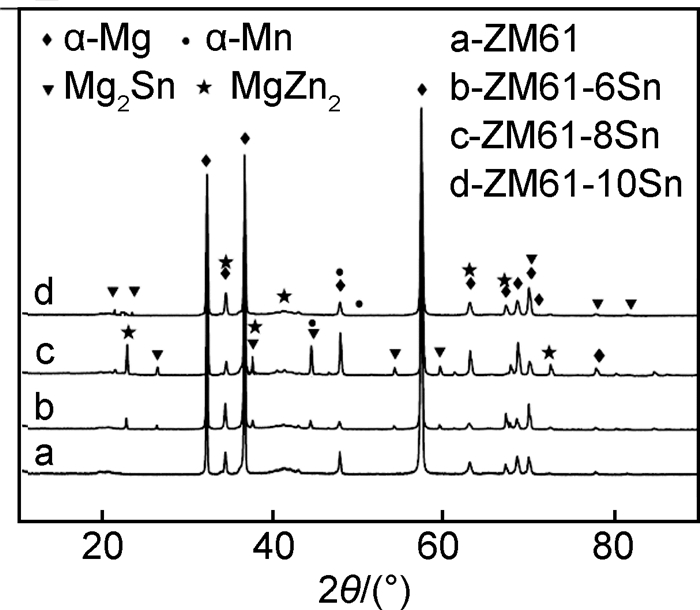
|
图 1 实验合金的XRD图谱 Fig. 1 XRD patterns of tested alloys |
图 2为时效态ZM61-xSn (x=0,6,8,10)合金的金相显微组织。添加Sn元素后,基体上弥散的分布着第二相颗粒,且体积分数随着Sn含量的增加而增加。结合物相分析结果可知,这些颗粒第二相主要为MgZn2相与Mg2Sn相。合金为等轴晶组织,晶粒尺寸随着Sn含量的增加而减小,ZM61-xSn (x=0,6,8,10)合金的平均晶粒尺寸分别为59,42,25,19μm。齐福刚[16]研究表明,Mg2Sn相具有较好的热稳定性,在440℃进行固溶处理只有少量的Mg2Sn相溶解于基体。而这些未溶于基体的Mg2Sn相在固溶过程中抑制晶粒的长大,所以ZM61-xSn (x=0,6,8,10)合金的晶粒尺寸随着Sn含量的增加而减小。
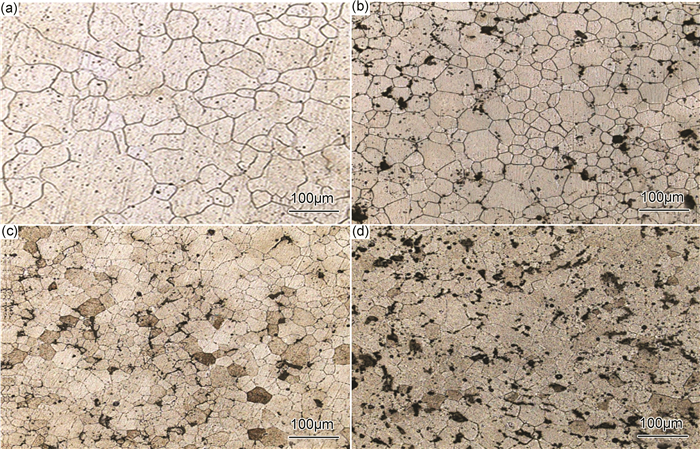
|
图 2 实验合金的金相组织(a) ZM61;(b) ZM61-6Sn; (c) ZM61-8Sn; (d) ZM61-10Sn Fig. 2 Optical images of tested alloys (a) ZM61;(b) ZM61-6Sn; (c) ZM61-8Sn; (d) ZM61-10Sn |
图 3为时效态ZM61-xSn (x=0,6,8,10)合金在180,220,260,300℃下的高温力学性能。从图 3(a)和(b)中可看出,随着拉伸温度的升高,合金的强度呈下降趋势,但含Sn元素的ZM61-xSn (x=6,8,10)合金的屈服强度(YS)和抗拉强度(UTS)均明显高于ZM61合金。当拉伸温度为300℃时,ZM61-xSn (x=6,8,10)合金的抗拉强度分别达到149,140,145MPa,较相同拉伸温度下ZM61合金的强度分别提高了26%,17%,23%。时效态的商用耐热镁合金QE22A,200℃的屈服强度为165MPa[17]。时效态的Mg-MM-Zn-Zr合金和Mg-Nd-Zn-Zr合金,300℃的抗拉强度分别为105 MPa和135 MPa [18]。因此,ZM61-xSn (x=6,8,10)合金的高温强度优于部分高成本的稀土镁合金。
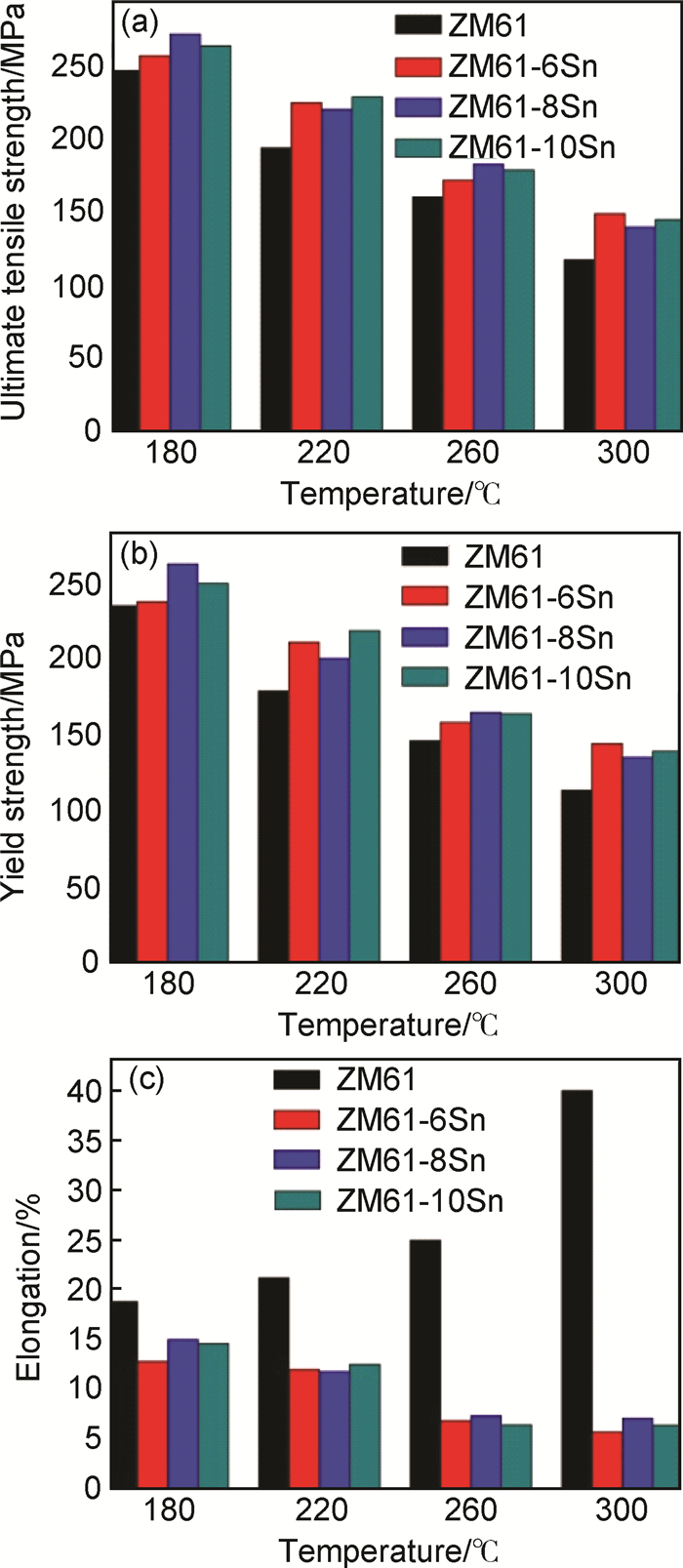
|
图 3 实验合金高温力学性能(a)抗拉强度;(b)屈服强度;(c)伸长率 Fig. 3 High temperature mechanical properties of tested alloys (a) ultimate tensile strength; (b) yield strength; (c) elongation |
由图 3(c)可知,Sn元素显著降低合金的高温伸长率,拉伸温度为300℃时,ZM61合金的伸长率(EL)为39.95%,而ZM61-xSn (x=6,8,10)合金的伸长率均下降到10%以下。随拉伸温度升高,ZM61合金的伸长率逐渐增大,而ZM61-xSn (x=6,8,100)合金的伸长率不断降低。当拉伸温度从180℃升高到300℃,ZM61-xSn (x=6,8,10)合金的伸长率分别从12.73%,14.93%,14.54%下降到5.65%,7.01%,6.33%,具体原因将结合后面断口形貌进行分析。
2.3 断口形貌分析图 4为时效态ZM61和ZM61-8Sn合金在180,220,260,300℃温度下的拉伸断口扫描形貌。拉伸温度对合金的断口形貌产生显著影响。当拉伸温度低于220℃,ZM61合金断口主要由解理刻面和撕裂棱组成,当拉伸温度高于220℃,断口主要由解理刻面组成。添加Sn元素后,合金的断口形貌发生变化,当拉伸温度低于220℃,ZM61-8Sn合金的断口主要由撕裂棱、韧窝和第二相颗粒组成;当拉伸温度高于220℃,断口上第二相颗粒数量减少,尺寸增大,韧窝的数量明显减少,断口呈典型的沿晶断裂特征。由图 4(a-2)~(d-2)可见,添加Sn元素后,合金中形成较多第二相,结合物相分析及能谱检测结果可知(见表 2),这些第二相主要为MgZn2相和Mg2Sn相,其中Mg2Sn相为高熔点相,在300℃下几乎不发生分解,并且显微硬度较高[19],不易产生塑性变形,在高温下可有效阻碍位错运动,因而提高合金高温强度。然而,过多的第二相会破坏基体间的连续性[20],使合金塑性降低。
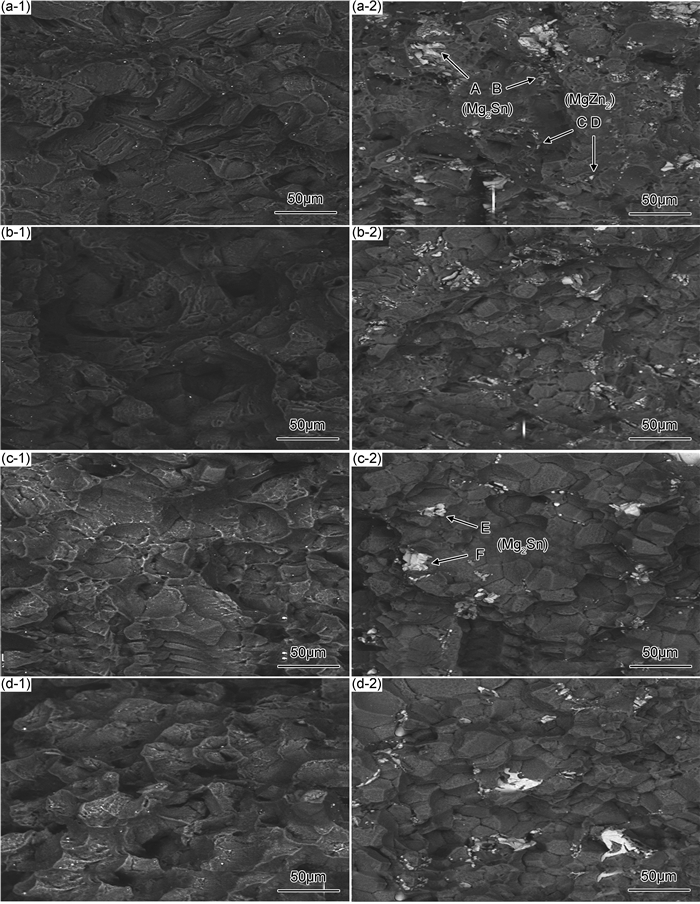
|
图 4 ZM61(1)和ZM61-8Sn (2)合金不同温度下拉伸断口扫描形貌(a)180℃; (b)220℃; (c)260℃; (d)300℃ Fig. 4 SEM images of fracture surface of ZM61(1) and ZM61-8Sn (2) alloys tested at different temperatures (a)180℃; (b)220℃; (c)260℃; (d)300℃ |
图 5为ZM61和ZM61-8Sn合金分别在180,220,260,300℃下的拉伸断口纵截面金相组织。由图可知,当拉伸温度低于220℃时,在合金断口以及断口附近形成大量孪晶(如图中圆圈所示),随拉伸温度升高,孪晶数量明显减少[21]。这是由于镁合金为密排六方结构,在较低的变形温度下可启动的滑移系较少,主要为基面滑移,不能满足Mises塑性变形准则(至少有5个独立滑移系启动),因此产生位错塞积使应力不断集中,促进孪晶形核,形成的孪晶可改变晶粒的取向从而协调塑性变形[22]。随变形温度升高,高于225℃后,非基面滑移系的临界分切应力大大降低,非基面滑移系开动,产生了位错的滑移及攀移,孪晶的形核和长大受到抑制,孪晶的数量显著减少。拉伸温度升高至300℃,发生了晶界滑移(如图中方框所示)。
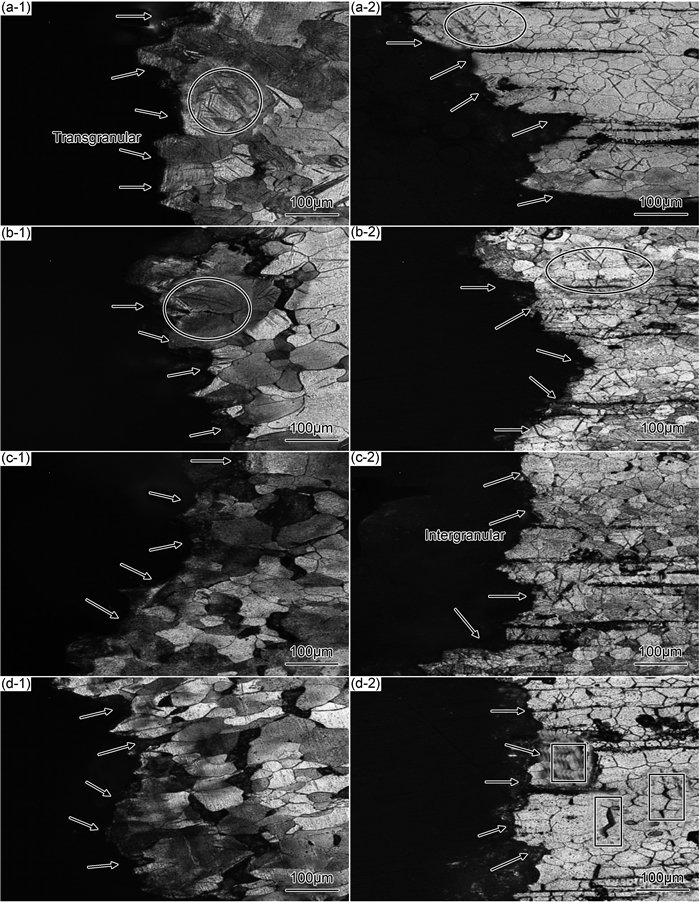
|
图 5 ZM61(1)和ZM61-8Sn (2)合金不同温度下断口截面金相组织(a)180℃; (b)220℃; (c)260℃; (d)300℃ Fig. 5 Optical images of the fracture section of ZM61(1) and ZM61-8Sn (2) alloys tested at different temperatures (a)180℃; (b)220℃; (c)260℃; (d)300℃ |
如图 5(a-1), (b-1), (c-1),(d-1),在180,220,260,300℃下拉伸变形过程中,ZM61合金的断裂机制为穿晶断裂(如图中箭头所示)。如图 5(a-2), (b-2), (c-2),(d-2),添加Sn元素后,合金的断裂机制随温度变化发生改变,当拉伸温度低于220℃,ZM61-8Sn合金的断裂方式为穿晶断裂。当拉伸温度高于220℃,合金的断裂方式变为沿晶断裂(如图 5(c-2), (d-2)箭头所示)。ZM61-6Sn及ZM61-10Sn合金在相同拉伸温度下的断裂机制与ZM61-8Sn合金相同,当拉伸温度高于220℃后均发生沿晶断裂,这就明显降低了Mg-Zn-Mn-Sn系合金的高温变形能力,也是造成合金高温塑性下降的原因。
图 6所示为ZM61-6Sn和ZM61-8Sn合金在不同温度下拉伸后断口的纵截面扫描组织,当拉伸温度为220℃时,在合金晶界上可观察到少量孔洞缺陷(如图 6(a-1), (b-1)箭头所示),当拉伸温度升高到260℃后,孔洞缺陷增多且沿晶界连接形成裂纹(如图 6(a-2), (b-2)箭头所示)。这是由于添加过量的Sn,在晶界处形成粗大的Mg2Sn颗粒,这些粗大的第二相导致晶粒间结合力减弱,变形过程中位错运动到晶界处产生塞积,造成应力集中,易产生孔洞缺陷。此外,随拉伸温度升高,合金晶界发生软化,产生晶界滑移,晶间结合力减弱,促进裂纹的萌生和扩展。因此,在它们的共同作用下,当拉伸温度达到260℃后,合金的断裂方式以沿晶断裂为主。
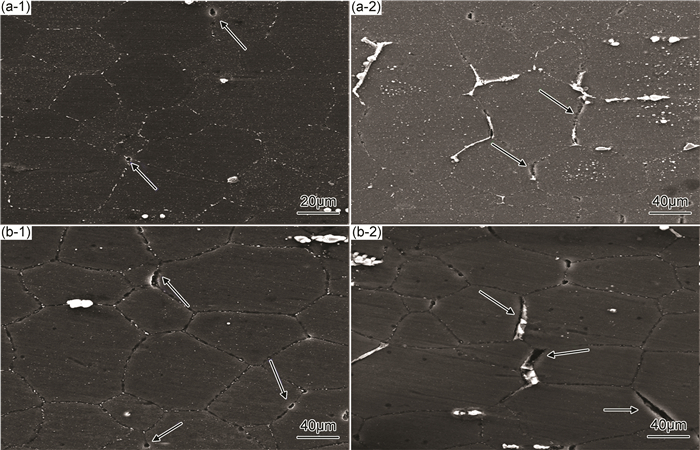
|
图 6 ZM61-6Sn (1)和ZM61-8Sn (2)合金不同温度的拉伸断口纵截面扫描组织(a)220℃;(b)260℃ Fig. 6 SEM images of the longitudinal section of fracture of ZM61-6Sn (1) and ZM61-8Sn (2) alloys tested at different temperatures (a)220℃; (b)260℃ |
(1)添加Sn元素后,合金相组成为α-Mg, α-Mn, MgZn2, Mg2Sn相;合金的组织得到细化,ZM61-xSn (x=0,6,8,10)合金的平均晶粒尺寸分别为59,42,25, 19μm。
(2)添加Sn元素可有效提高Mg-Zn-Mn系合金的高温强度,然而,也会急剧降低合金的塑性。在拉伸温度为300℃时ZM61-xSn (x=0,6,8,10)合金的抗拉强度分别为118,149,140, 145MPa,伸长率分别为39.95%, 5.65%,7.01%, 6.33%。
(3)在低于220℃以下拉伸时,合金发生孪生变形,在断口附近可观察到大量孪晶;在高于220℃以上拉伸时,合金孪生变形受抑制,在断口附近无孪晶出现。
(4)随着拉伸温度的升高,合金的断裂机制发生变化,伸长率降低。粗大的Mg2Sn脆性相与基体结合力较弱,导致ZM61-xSn (x=6,8,10)合金的断裂机制在220℃发生转变,低于此温度,合金为穿晶断裂,高于此温度,合金发生沿晶断裂。
| [1] | 李轶, 李慧中, 姜俊, 等. 热处理对AZ80镁合金疲劳性能的影响[J]. 航空材料学报,2014, 34 (6) : 33 –39. LI Y, LI H Z, JIANG J, et al. Effect of heat treatment on fatigue properties of AZ80 magnesium alloy[J]. Journal of Aeronautical Materials,2014, 34 (6) : 33 –39. |
| [2] | LUO A A. Magnesium: current and potential automotive applications[J]. JOM,2002, 54 (2) : 42 –48. DOI: 10.1007/BF02701073 |
| [3] | 张丁非, 耿青梅, 杨绪盛, 等. 新型复合挤压工艺中温度对AZ61组织和性能的影响[J]. 材料工程,2014 (7) : 1 –4. ZHANG D F, GENG Q M, YANG X S, et al. Effects of temperature in the new compound extrusion on microstructures and properties of AZ61[J]. Journal of Materials Engineering,2014 (7) : 1 –4. |
| [4] | SESHACHARYULU T, PRASAD Y. Modeling of hot deformation for microstructural control[J]. International Materials Reviews,1988, 43 (6) : 243 –258. |
| [5] | 彭建, 彭毅, 韩韡, 等. 挤压温度对Mg-2Zn-Mn-0.5Nd镁合金组织和性能的影响[J]. 材料工程,2015, 43 (3) : 23 –27. PENG J, PENG Y, HAN W, et al. Effect of extruded temperature on microstructure and mechanical properties of Mg-2Zn-Mn-0.5Nd alloy[J]. Journal of Materials Engineering,2015, 43 (3) : 23 –27. |
| [6] | SHA G. Hardening and microstructural reactions in high-temperature equal-channel angular pressed Mg-Nd-Gd-Zn-Zr alloy[J]. Materials Science and Engineering: A,2010, 527 : 5092 –5099. DOI: 10.1016/j.msea.2010.04.064 |
| [7] | KIM D, LIM H, KIM Y, et al. High temperature deformation behavior of Mg-Sn (Zn) alloy[J]. Metals & Materials International,2011, 17 (17) : 383 –388. |
| [8] | YANG H, YONG B, CUI H. High-temperature creep behavior of Mg-9Gd-4Y-0.5Zr alloy[J]. Heat Treatment of Metals,2012, 37 (6) : 25 –29. |
| [9] | HASSAN S F, TAN M J, GUPTA M. High-temperature tensile properties of Mg/Al2O3, nanocomposite[J]. Materials Science & Engineering: A,2008, 486 (1-2) : 56 –62. |
| [10] | SASAKI T T, YAMAMOTO K, HONMA T, et al. A high-strength Mg-Sn-Zn-Al alloy extruded at low temperature[J]. Scripta Materialia,2008, 59 (10) : 1111 –1114. DOI: 10.1016/j.scriptamat.2008.07.042 |
| [11] | WANG Q, CHEN Y G, XIAO S F, et al. Microstructures, mechanical properties and compressive creep behaviors of as-cast Mg-5%Sn-(0-1.0)%Pb alloys[J]. Journal of Central South University of Technology,2011, 18 (2) : 290 –295. DOI: 10.1007/s11771-011-0693-7 |
| [12] | SASAKI T T, OHISHI K, OHKUBO T, et al. Enhanced age hardening response by the addition of Zn in Mg-Sn alloys[J]. Scripta Materialia,2006, 55 (3) : 251 –254. DOI: 10.1016/j.scriptamat.2006.04.005 |
| [13] | YANG M, M Y, YANG M, et al. Effects of heat treatment on microstructure and mechanical properties of Mg-3Sn-1Mn magnesium alloy[J]. Transactions of Nonferrous Metals Society of China,2011 (10) : 2168 –2174. |
| [14] | SHI Z Z, ZHANG W Z, GU X F. Characterization and interpretation of the morphology of a Mg2Sn precipitate with irrational facets in a Mg-Sn-Mn alloy[J]. Philosophical Magazine,2011, 92 (9) : 1 –12. |
| [15] | 张丁非, 徐杏杏, 齐福刚, 等. Sn对ZM61合金组织与性能的影响[J]. 稀有金属材料与工程,2013 (5) : 931 –936. ZHANG D F, XU X X, QI F G, et al. Effects of Sn on microstructure and mechanical properties of ZM61 alloy[J]. Rare Metal Materials and Engineering,2013 (5) : 931 –936. |
| [16] | 齐福刚. Sn和Ce对Mg-Zn-Mn高强变形镁合金组织和性能的影响[D].重庆:重庆大学, 2012. QI F G. Effect of Sn and Ce on microstructure and properties of Mg-Zn-Mn high strength wrought alloy[D]. Chongqing: Chongqing University, 2012. http://cdmd.cnki.com.cn/Article/CDMD-10611-1013008071.htm |
| [17] | 罗素琴, 潘复生, 汤爱涛. 含W相Mg-Zn-Zr-Y合金组织和高温力学性能研究[J]. 热加工工艺,2012 (10) : 41 –44. LUO S Q, PAN F S, TANG A T. Microstructure and mechanical properties at elevated temperature of Mg-Zn-Zr-Y alloy with W phase[J]. Hot Working Technology,2012 (10) : 41 –44. |
| [18] | 陈振华. 耐热镁合金[M]. 北京: 化学工业出版社, 2006 . |
| [19] | 王耀贵, 李全安, 张清, 等. Sn在耐热镁合金中的应用[J]. 轻金属,2011 (12) : 43 –46. WANG Y G, LI Q A, ZHANG Q, et al. Application of Sn in heat resistant magnesium alloy[J]. Light Metals,2011 (12) : 43 –46. |
| [20] | 谢建昌, 李全安, 李建弘, 等. Ca对AZ81镁合金高温性能的影响[J]. 轻金属,2007 (12) : 58 –62. XIE J C, LI Q A, LI J H, et al. Influence of Ca on mechanical properties of AZ81 Mg alloy[J]. Light Metals,2007 (12) : 58 –62. |
| [21] | YOO M H. Slip, twinning, and fracture in hexagonal close-packed metals[J]. Metallurgical Transactions A,1981, 12 (3) : 409 –418. DOI: 10.1007/BF02648537 |
| [22] | CHOI S H, SHIN E J, SEONG B S. Simulation of deformation twins and deformation texture in an AZ31 Mg alloy under uniaxial compression[J]. Acta Materialia,2007, 55 (12) : 4181 –4192. DOI: 10.1016/j.actamat.2007.03.015 |
 2016, Vol. 44
2016, Vol. 44


